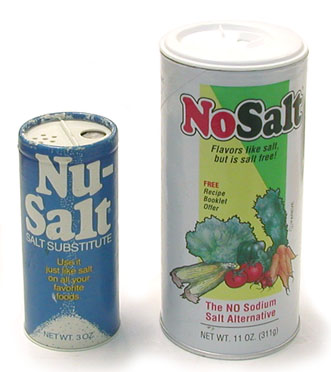Low Sodium Salt Substitutes
The great thing about a low-sodium salt substitute, aside from the fact that it is measurably radioactive, is that people put it on their food! Not to worry—consuming a salt substitute doesn’t increase your radiation exposure.
Salt substitutes are radioactive because they contain potassium chloride, and all potassium contains the radioactive beta-gamma emitter potassium-40.
Potassium-40 (K-40) is a naturally-occurring radionuclide. Wherever there is potassium, there is potassium-40. If there is enough potassium, the K-40 can be detectable with a simple survey instrument.
Data
K-40 half-life: 1.28 x 109 years
K-40 decay mode:
- Beta decay (89.3%). The beta maximum energy is 1.31 MeV.
- Electron capture: (10.7%)
- Gamma rays: 1461 keV (10.7%)
Daily intake of potassium element: 3.3 grams
Amount of potassium element in body: 140 grams (1.5 pCi/g or 55 Bq/kg of body weight)
Typical K-40 activity in body: 0.1 uCi. This means that there are over 200,000 atoms of K-40 that decay in the body each minute!
Typical K-40 activity in soil: 10 to 20 pCi/g
Dose from Potassium-40
The dose to a typical member of the population is approximately 15-20 mrem/year due to the K-40 in the body and 10 mrem/year due to the gamma rays emitted by K-40 in the environment (primarily the soil).
The human body maintains relatively tight homeostatic control over potassium levels. This means that the consumption of foods containing large amounts of potassium will not increase the body’s potassium content. As such, eating foods like bananas does not increase your annual radiation dose. If someone ingested potassium that had been enriched in K-40, that would be another story.

Salt substitutes vary in their composition, but their main ingredient is always potassium chloride. For example, the listed contents of the Nu-Salt are: potassium chloride, cream of tartar, drier and natural flavor derived from yeast. Contains less than 20mg of sodium per 100 grams. The contents of the NoSalt are: potassium chloride, potassium bitartrate, adipic acid, mineral oil, fumaric acid and silicon dioxide. The ingredients of another salt substitute, not shown here, are: potassium chloride, L-glutamic acid, mono-potassium glutamate, tri-calcium phosphate and 0.01% potassium iodide.
A salt substitute does not taste exactly like sodium chloride, but it is similar enough, and it contains less or none of the sodium that some people are trying to avoid.
To measure the activity of a low sodium salt, pour some onto a piece of paper (the paper makes it easier to get the salt back into the container). The idea is to detect the K-40 beta particles rather than the gamma rays, and getting the salt out of the container helps in this regard. Be sure to use plenty of “salt,” e.g., 5-10 grams. Perhaps the best readily available detector to use is a thin window Geiger Mueller detector (e.g., a pancake GM). A detector with an audio output that is nice and loud makes for a better demonstration. Before you make the actual measurement, listen to the background for a while. Then, when the suspense is just about to become unbearable, quickly move the probe onto the surface of the salt. If the gods are smiling, the count rate should more than double. Finally, don’t forget to clean the probe after the demonstration since residual salt substitute will increase the background.
